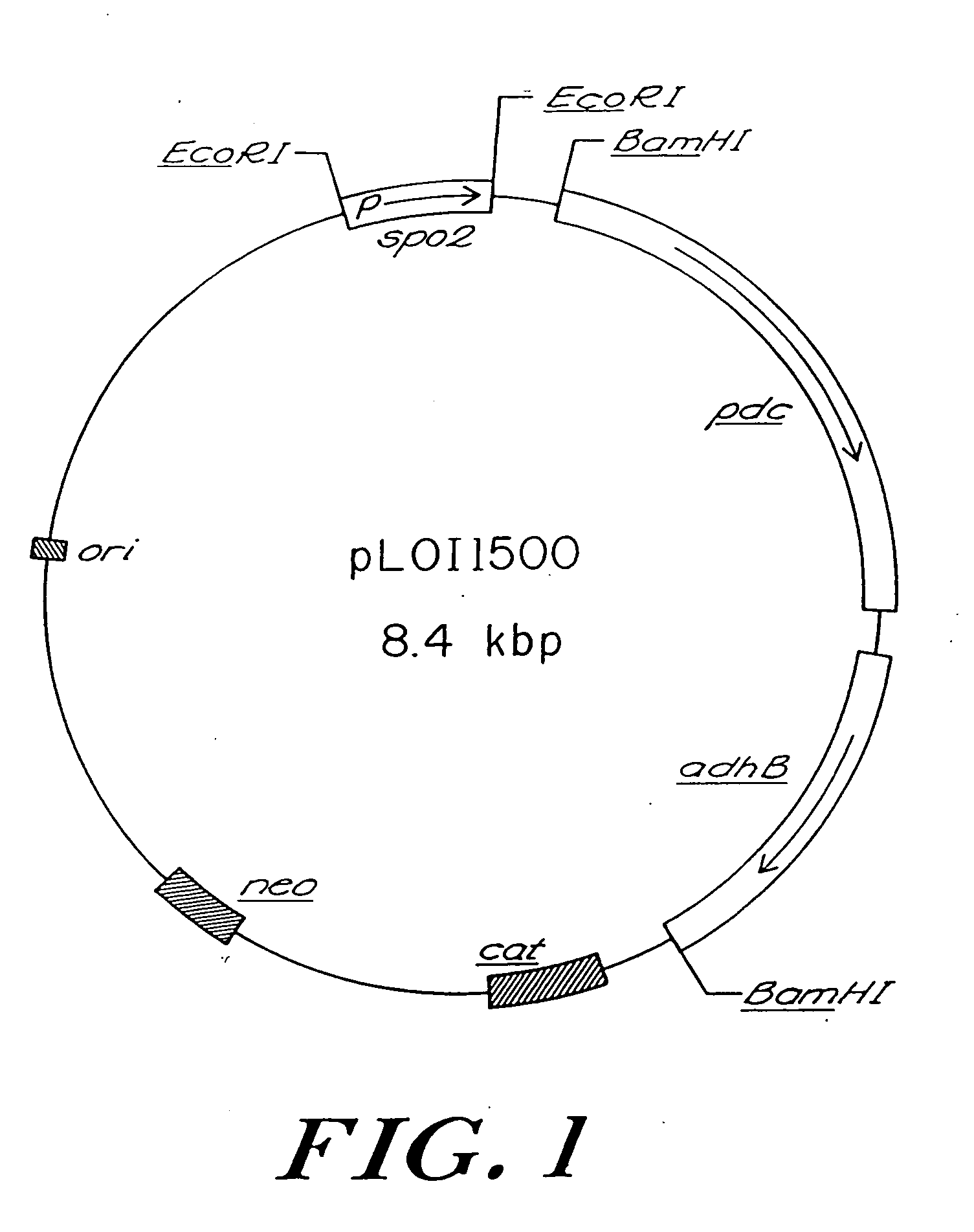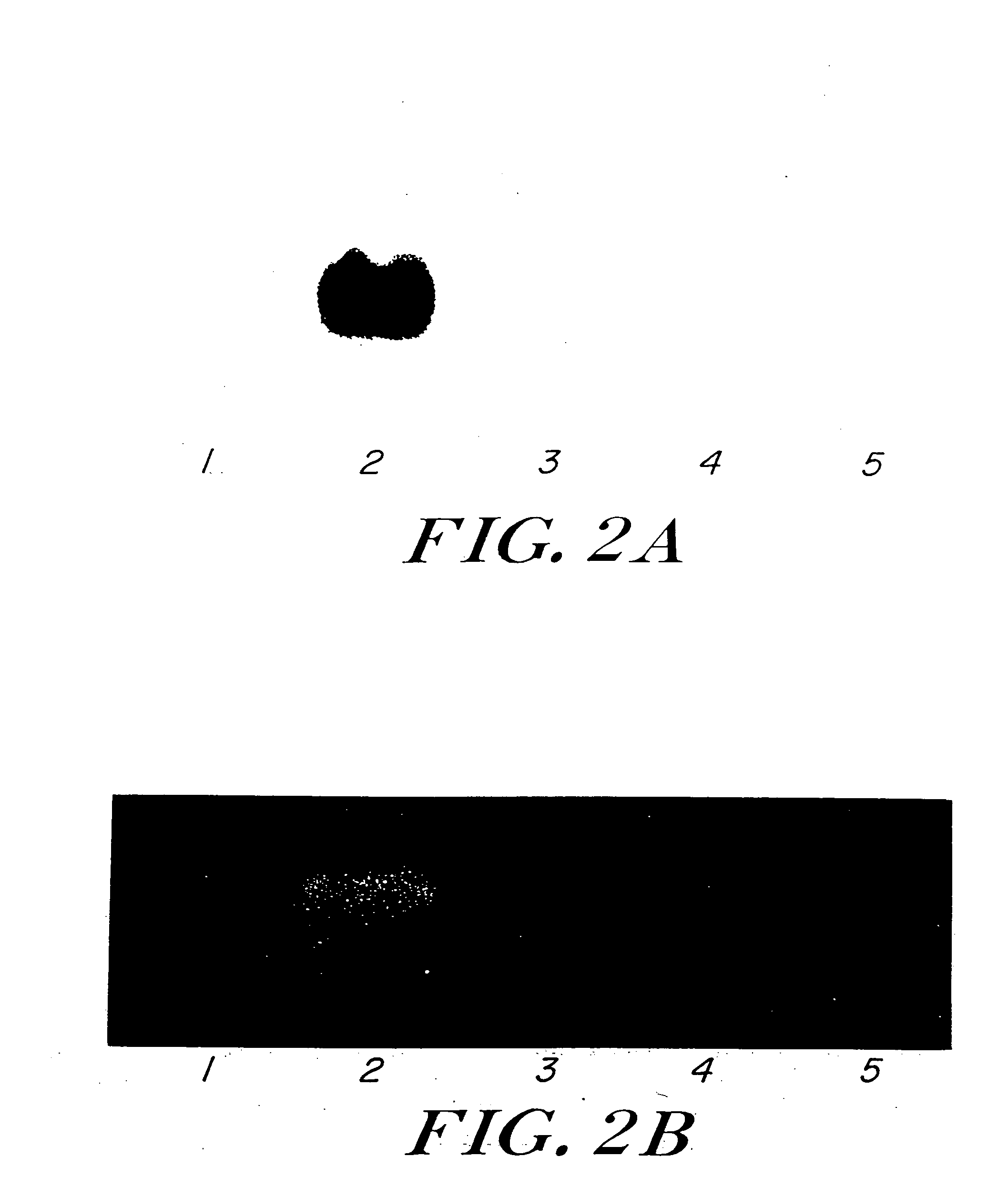Ethanol production in gram-positive microbes
a technology of ethanol production and gram-positive bacteria, which is applied in the field of ethanol production in gram-positive microorganisms, can solve the problems of difficult efficient fermentation of pentose-fermenting yeasts, increased toxic effects upon accumulation, and no naturally occurring microorganisms have been found to rapidly and efficiently ferment pentoses to high levels, so as to improve the ethanol production rate of recombinant bacteria, reduce the accumulation of acidic metabolic products, and enhance the ethanol production rate of recomb
- Summary
- Abstract
- Description
- Claims
- Application Information
AI Technical Summary
Benefits of technology
Problems solved by technology
Method used
Image
Examples
example 1
Plasmid Construction and Transformation
[0063] A promoterless pet operon was isolated as a 3.2 kilobase pair (kbp) BamHI fragment from pLOI292. This fragment was ligated into the BamHI site of the Bacillus expression vector, pPL708, under the control of the spo promoter (Schoner et al., 1983) to produce pLOI1500 (FIG. 1). To confirm that the Z. mobilis genes were not altered during construction or maintenance in B. subtilis YB886, the 3.2 kbp BamHI fragment was reisolated from YB886 (pLOI1500) and subcloned into pUC18 to produce pLOI1528. PDC and ADHII activities in E. coli DH5α (pLOI1528) (Table 1) were equivalent to those expressed by an analogous construct, pLOI295 (Ingram and Conway, 1988), the source of the pet operon for pLOI292.
TABLE 1PDC and ADHII activities in recombinant strains ofE. coli DH5α and B. subtilis YB886Specific activityaADHIIPDCE. coli DH5DH5α(pLOI292)0.810.94DH5α(pLOI1528)b3.62.9B. subtilis YB886ndcYB886(pLOI1500)0.17nd
aExpressed as μmo1es of substrate / minut...
example 2
Expression of Proteins Encoded by Z. mobilis Genes
[0064] The expression of both Z. mobilis pdc and adhB was confirmed immunologically in colony lifts using polyclonal antisera (Aldrich et al., 1992). Western blots revealed the presence of full length subunits for both PDC and ADHII. Two new smaller proteins were observed in stained gels, ca. mass of 14,000 (14K) and 33,000 (33K) daltons. It is unlikely that these smaller proteins are degradation products of Z. mobilis enzymes since both failed to react with either polyclonal antibody. The 14K and 33K proteins were present only in YB886 recombinants which expressed the Z. mobilis genes. Deletion of the spo promoter (EcoRI fragment) to produce pLOI1503 eliminated their expression, the inhibition of growth, and the expression of the Z. mobilis genes in recombinant YB886.
[0065] A second higher molecular weight band was also detected in YB886(pLOI1500) with antisera to ADHII, an abundant Z. mobilis stress protein (An et al., 1991). Thi...
example 3
Expression of Functional PDC and ADHII
[0066] ADHII activity was readily measured in protein extracts from YB886(pLOI1500) (Table 1). PDC activity could not be determined in B. subtilis due to the high background levels of native, heat-stable lactate dehydrogenase (Conway et al., 1987). The expression of both Z. mobilis adhB and pdc as functional enzymes in YB886(pLOI1500) was confirmed by activity stains of native gels (FIG. 2 (A and B, respectively)).
[0067] Additional plasmids were constructed for expression of the Z. mobilis genes in YB886. The promoterless plasmid, pLOI1503, was used as a recipient for 1 to 3 kbp PstI fragments of YB886 chromosomal DNA as a source of native promoters. Although many positive clones were identified in colony lifts, none appeared more active than pLOI1500.
EXAMPLE 4
Alternative Hosts
[0068] Several additional strains of Bacillus were also tested as hosts. Successful transformations of pLOI1500 without rearrangement were achieved with B. polymyxa N...
PUM
| Property | Measurement | Unit |
|---|---|---|
| natural abundance | aaaaa | aaaaa |
| concentrations | aaaaa | aaaaa |
| thermostable | aaaaa | aaaaa |
Abstract
Description
Claims
Application Information
 Login to View More
Login to View More - R&D
- Intellectual Property
- Life Sciences
- Materials
- Tech Scout
- Unparalleled Data Quality
- Higher Quality Content
- 60% Fewer Hallucinations
Browse by: Latest US Patents, China's latest patents, Technical Efficacy Thesaurus, Application Domain, Technology Topic, Popular Technical Reports.
© 2025 PatSnap. All rights reserved.Legal|Privacy policy|Modern Slavery Act Transparency Statement|Sitemap|About US| Contact US: help@patsnap.com


